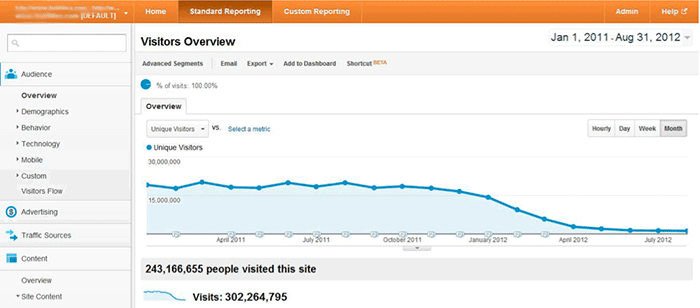After all the Google algorithm updates such as Penguin, Panda and the rest of the zoo were announced, a lot of sites have noticed a dip in their search engine traffic.
As a CMO you might get lost in all the explanations and technical jargon surrounding these updates, and you’re probably clueless as to why you’ve lost all this web traffic. If you log into your Google Analytics account and you see a graph similar to the one below, this post will help you understand why your traffic has tanked and never got back to its normal figures:

Quality vs Quantity Search Engine Traffic
There was a time when getting your site to rank in Google was pretty easy. All you needed was a bunch of links from other sites pointing to your website, alone with the time it took to stuff your web content with keywords that you wanted to rank for. One of the quickest ways to get links to your site was to create multitudes of articles (which would usually be copied from other sites) that would include a number of keywords in them. You would then submit these articles to article directories.
A common procedure was to use an article, submit it to a site and then slightly modify a few sentences here and there and resubmit it to another site. This process was repeated over and over again, such that by the end of it, the article won’t make much sense anymore. Why was it done? Essentially, everyone tried to cheat Google and other search engines into thinking that the articles posted were unique. An alternative quick-fix for getting links to your site was to spam blogs and forums with a link back to your site. A high traffic keyword would be used to attach the link to your site, also known as anchor text. Check the example below:

This was the norm, done by thousands in order to rank highly in Google for that specific keyword. To outrank competitors a lot of companies enrolled in cheap link building services that were getting them the results they wanted in the short run.
Is this all sounding familiar? If you’ve ever done some or most of the above, that’s probably the reason behind your fall in Google rankings. The downside is that in order to repair all the damages it is going to cost you quite a lot of time and money. But don’t fret, this is probably the best investment you’ll ever make for your business. Why will it take time? Simple – you will need to remove each and every link that you have in these types of sites. Then, together with your web marketing team, you will have to start attracting good quality links to your site. The longer you take to do this, the more it will cost you in the long run. Keep in mind the online sales that you would be losing on a daily basis.
Remember this: unfortunately a lot of companies focus their web marketing strategies on quick wins. The longer it takes you to understand that there are no quick wins with search engine optimisation, the more money it’s going to cost your business. But enough about that. The underlying lesson here is to shift your strategy and focus more on quality rather than quantity. This is the basic principle to understand all Google updates which primarily focus on web spam. You have to relate this to both content and link-building since they are the two main issues that directly affect your Google rankings.
Fighting Web Spam
Google is quite clear on this: Any and all spammy websites are banned from ranking in their search engine. Google’s main focus is on the user experience. This means that if a website doesn’t offer value to the reader it will simply fall in the rankings. As mentioned before, you have to see this from two different perspectives: from the content side and from the link-building side. In terms of content these are the main issues that will negatively affect your rankings:
Keyword Stuffing
When you make excessive use of the same keyword in the website’s content or meta tags (the top part of the html code of a web page that includes the page’s title and description) with the intention to attract more traffic to your website. This will lose the flow of the content and adds no value to the reader. Below is an obvious keyword stuffing example just to give you a better idea:
“Yes, we do have white cups and our cups are white and they are cups and the other white cups are not as good as our white cups because cups in general are white and our cups are white too”.
This sentence will get your site to rank for the keyword “white cups” and potential customers landed on your website. Once they read the above sentence, however, they will most definitely go and buy from another site. Which makes one very valid point: there is no point of attracting visitors to your site if you’re not managing to sell your products. From now on, before uploading content to your site, make sure that it adds value to the reader. Just for a moment, forget about ranking in Google and focus on producing amazing content that your readers will find useful.
Duplicate Content
This refers to the content on a website that is used more than once repeatedly, or else is copied directly from other sites. The main intention here was previously meant to increase the kind of content that helped in improving the rankings in Google. Not anymore though. If you really want to rank in Google the content on your website has to be unique. If you have any duplicate content, either that which is stolen from other sites or that which is repeated over and over again throughout your website, Google will penalise your site. To solve this problem your web marketing team should remove any duplicate content from your website and publish fresh new content in it’s place.
The way forward in terms of SEO is to focus on one basic principle in everything that you do. Make sure that all the content that you produce as a company will be valuable to the reader. Whether it is a feature list or a blog post, ask yourself: does this help my readers? If not, you’ll be better off not posting it at all. After all, you will only be damaging your brand. This also relates to link building – Make sure that you know what techniques your web marketing agency is using. If they’re trying to get links the easy way, you’re probably getting low quality links which will only harm your rankings.





